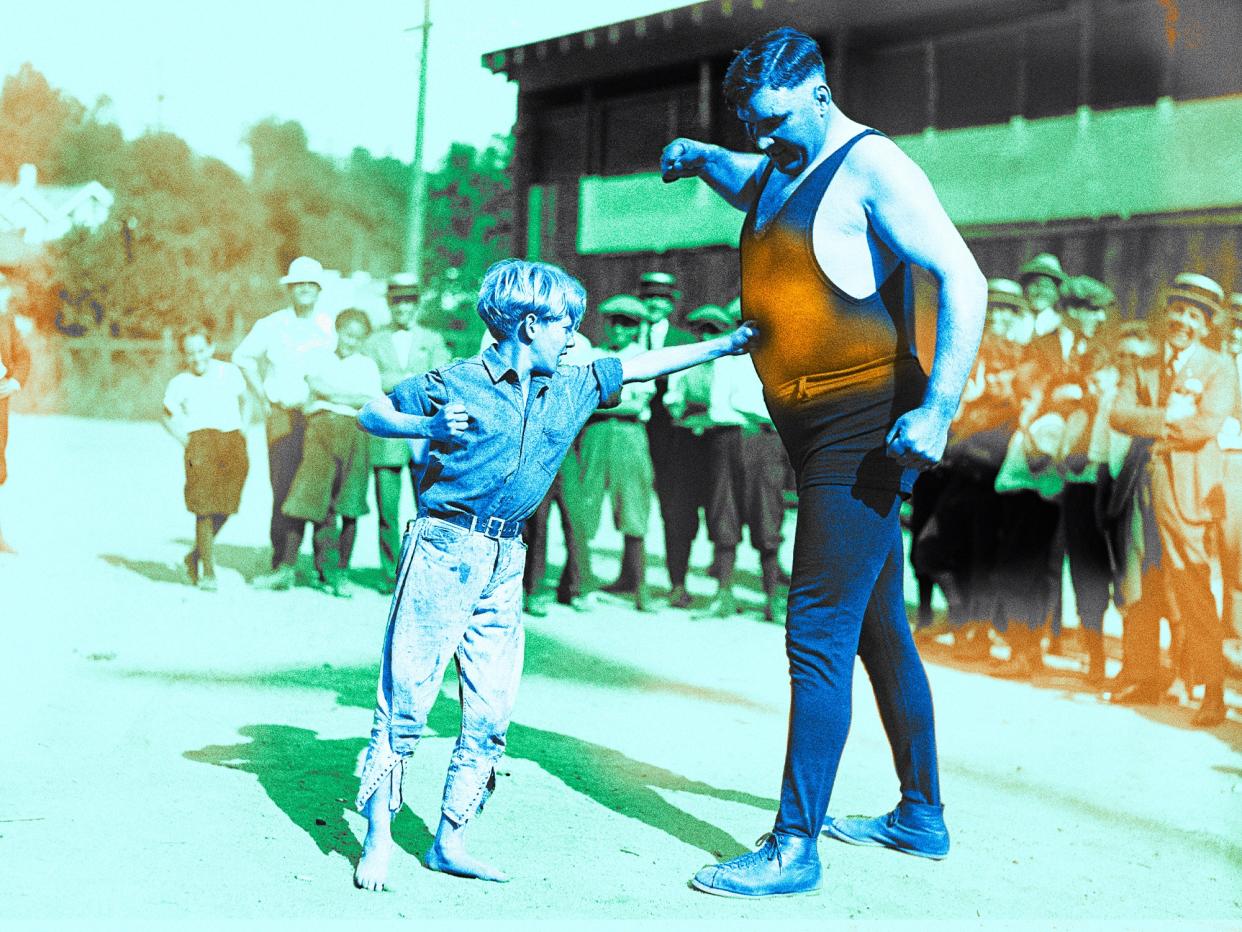Can Getting Punched in the Stomach Improve Your Workout?

Photograph: Getty Images; Collage: Gabe Conte
There’s a time and a place for so many things in life, but one of those things is probably not getting punched in the stomach repeatedly as part of an abs workout. And yet: Earlier this year, one Jake Gyllenhaal posted a video on Instagram of himself getting punched in the stomach 40 times as part of his training for Road House, in which he plays a UFC fighter. “Excuse me while I go pee blood,” he (hopefully) jokes to the camera after receiving the blows. “We want the movie to be good…what we’re doing is real,” he continues. The video now has more than 90,000 comments, many of which congratulate the actor’s commitment and dedication.
Given that his abs are so chiseled, they could pass for a Teenage Mutant Ninja Turtle's, it might appear that taking hits to the gut is indeed a great way to get toned. But before you cancel your gym membership in favor of asking your buddy to give you their best sucker punch, know that trainers say that for the most part, stomach punching is a form of a body shot that is simply not a safe—or even necessarily effective—method for strengthening your abs.
“Some boxers and MMA fighters will practice taking body shots as a form of their training,” says Victor Acosta, Muay Thai coach and owner of the Thai Boxing Institute in Los Angeles. A body shot, he says, is any hit that lands below the neck, and that can include the abdomen. But he adds that “if you are not a combat sports athlete—if you’re a ‘normie’, and you’re just training for fitness—you shouldn’t be getting hit in the body.”
The purpose of stomach punching in workouts
In the world of combat sports, learning to take body shots is a form of resilience training, says Martin Wheeler, a leading martial arts expert and trainer in Los Angeles. “The basic idea behind any type of resilience training is to prepare you for combat so that when you get hit, it's not the first time it’s happening to you,” he says. “You're creating a condition for the body that it can recognize. The hardest thing about getting hit in the stomach is if you've never been hit in the stomach.” Once you know what to expect and what to expect about how it feels, handling the fallout in real time is easier—and this is a skill that stands to serve combat-arts fighters.
In addition to building mental stamina, receiving body shots “helps with reflexes and inflection, contracting the muscles to protect you, to brace your body to be able to receive impact,” Acosta says.
Acosta and Wheeler agree that practicing body shots to the abs as part of martial arts training under the guidance of a trainer who can facilitate a safe atmosphere can be appropriate—and, yes, it can also build strength for the abs. “Anytime you’re breaking down the fibers in the muscle, the more it has to rebuild, so you’re building stronger muscles, basically,” Wheeler says.
The risks of stomach-punching in workouts
While stomach-punching can appeal to abs strength, the risk of injury simply doesn’t outweigh the reward of muscle gains—particularly because there are so many other effective and safe ways to achieve the same result.
“It’s a drill from the combative arts realm—it’s not done in cosmetic training.” says Jason Kozma, Los Angeles personal trainer and former Mr. America. “If you punch somebody too hard and they’re not prepared, they could die.” Back in 1926, magician Harry Houdini died after complications of appendicitis not long after he received a sucker punch without having prepped himself for the blow. (Whether or not the punch actually precipitated his appendicitis and then death has been a source of much debate.)
Even so, practicing stomach punching is indeed a safety concern that can lead to injuries like broken ribs and ruptured organs, Acosta says.
Ideas for safely working and toning your abs
Good news: You can still work on your own Teenage Mutant Ninja Turtle abs without ever receiving a punch. In fact, most of the exercises the trainers recommend to achieve the same aesthetic effect as bracing yourself for 40 punches doesn’t involve any contact with anything at all.
“If you want to have visible abs, then you want to do your extending and contracting exercises, like hanging leg raises, knee raises, crunches, and partial sit-ups,” says Kozma.
Acosta agrees, adding that ab-wheel workouts are a great option; he suggests any movement “where you hold positions, slowly contract your muscles, and then disengage them.”
No matter the exercise you’re doing, though, paying mind to how you feel is key for upholding your health and safety. “Listening to your body is really, really important when you’re doing any type of physical training,” Wheeler says. And that’s a truth worth your commitment—even if it doesn’t land you 90,000 Instagram comments.
Originally Appeared on GQ

